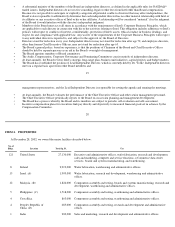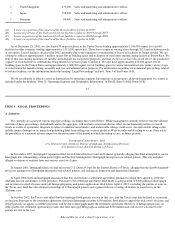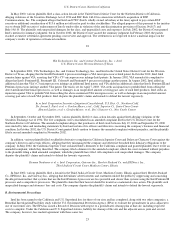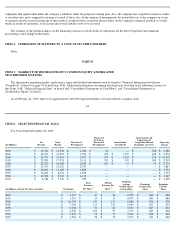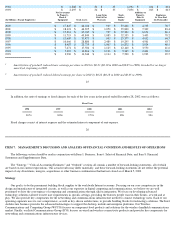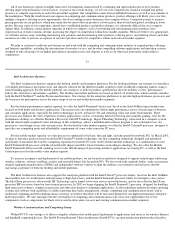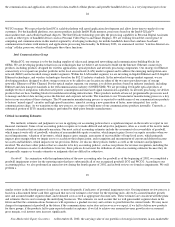Intel 2002 Annual Report Download - page 29
Download and view the complete annual report
Please find page 29 of the 2002 Intel annual report below. You can navigate through the pages in the report by either clicking on the pages listed below, or by using the keyword search tool below to find specific information within the annual report.
33
Despite the decline in net revenue for ICG, net operating results improved, with a loss of $622 million in 2002 compared to a loss of
$735 million in 2001. The impact of lower revenue was more than offset by the impact of reduced inventory writedowns in 2002 compared to
2001, as well as lower operating expenses and a shift to higher margin products, including network processing components and Ethernet
connection products.
For 2001, net revenue decreased by $903 million, or 26%, compared to 2000, primarily due to significantly lower unit volumes of
microcontrollers, network processing components, enterprise infrastructure and telecommunications products, including telecommunications
boards, consistent with an industry-wide reduction in demand for these products. The overall revenue decline was partially offset by incremental
revenue related to acquisitions completed in 2001.
Net operating results decreased by $1.1 billion to a loss of $735 million in 2001 from a profit of $319 million in 2000, primarily due to the
lower unit volumes of microcontrollers, network processing components and telecommunications-related products. Higher research and
development spending in 2001 also contributed to the decline, primarily due to the expenses of businesses acquired in 2001 and a full year of
expenses for acquisitions made in 2000.
Operating Expenses
Operating expenses for the three years ended December 28, 2002 were as follows:
Research and development spending, which excludes purchased in-process research and development (IPR&D), increased $238 million, or
6%, in 2002 compared to 2001 and decreased $101 million, or 3%, in 2001 compared to 2000. The increase in 2002 compared to 2001 was
primarily due to higher spending on development of manufacturing process technologies, including the 90-nanometer process on 300-millimeter
wafers. The decrease in 2001 compared to 2000 was primarily due to cost containment efforts, including reductions in discretionary spending on
research and development-related travel expenses.
Marketing, general and administrative expenses decreased $130 million, or 3%, in 2002 compared to 2001, primarily due to the impact of
lower spending within ICG and for certain new business initiatives as we reduced headcount or exited certain businesses, as well as lower overall
discretionary spending related to cost containment programs. The spending decreases were partially offset by higher expenses for the Intel
Inside® cooperative advertising program due to higher microprocessor revenue and the impact of our customers using a slightly higher
percentage of their available program funds. Marketing, general and administrative expenses decreased $625 million, or 12%, in 2001 compared
to 2000, primarily due to decreased cooperative advertising program expenses and profit-dependent bonus expenses, as well as lower
discretionary spending as a result of cost reduction programs, partially offset by marketing, general and administrative expenses from companies
acquired.
Amortization and impairment of acquisition-
related intangibles and costs was $548 million in 2002, including impairments of $127 million.
Amortization was $628 million in 2001, with $26 million of impairments, and $276 million in 2000. The decrease from 2001 to 2002 was due to
certain of the intangibles becoming fully amortized. The increase from 2000 to 2001 was primarily due to the impact of additional acquisitions.
Amortization of goodwill was $1.7 billion in 2001, including $98 million of impairments, and $1.3 billion in 2000, with the increase reflecting
the impact of additional acquisitions. Goodwill is no longer amortized, beginning in 2002. Amortization of acquisition-related costs for all
periods is included in the calculation of the operating loss for the "all other" category for segment reporting purposes.
34
Gains (Losses) on Equity Securities, Interest and Other, and Taxes
Gains (losses) on equity securities, net, interest and other, net and taxes for the three years ended December 28, 2002 were as follows:
(In Millions)
2002
2001
2000
Research and development
$
4,034
$
3,796
$
3,897
Marketing, general and administrative
$
4,334
$
4,464
$
5,089
Amortization of goodwill
$
—
$
1,710
$
1,310
Amortization and impairment of acquisition
-
related intangibles and costs
$
548
$
628
$
276
Purchased in
-
process research and development
$
20
$
198
$
109
(In Millions)
2002
2001
2000
Gains (losses) on equity securities, net
$
(372
)
$
(466
)
$
3,759


